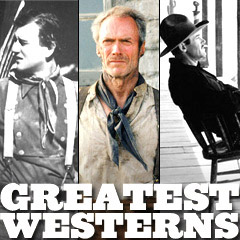
|
Greatest Westerns 1956-1959 |
| Film Title/Year/Director/Length/Studio, Setting (or Time Period) and Brief Description | |
The
Searchers (1956)
John Ford's complex, epic, 'psychological' Western story was about a man's obsessive five year quest for revenge, set in post-Civil War America. It was based on the best-selling 1954 novel by Alan Le May. This film was unquestionably Ford's finest, most influential, and most-admired film, and beautifully shot in his most popular locale, Monument Valley, but this exceptional film - a true American masterpiece of filmmaking, was not nominated for Academy Awards. As the film began in Texas of 1868, embittered loner and mysterious Civil War ex-Confederate soldier Ethan Edwards (John Wayne in a complex character role) entered on horseback, and arrived at the solitary, Texas frontier farm of his estranged brother Aaron Edwards' (Walter Coy) family with radiant wife Martha (Dorothy Jordan) - everyone expectantly watched his approach, including Ethan's two nieces: young Debbie Edwards (Lana Wood) and her older sister Lucy (Pippa Scott). Tension developed between the two brothers, because of Ethan's long-suppressed love for Aaron's wife Martha. Strains also developed between prejudiced, racist Indian hater and anti-hero Ethan and Aaron's half-breed adopted son, part-Cherokee (one-eighth) Martin "Marty" Pawley (Jeffrey Hunter). When the deputized Ethan and Martin joined a posse of Texas Rangers to investigate for Comanche marauders or cattle rustlers, they didn't know that they were deliberately being lured away. Upon their return to the Edwards' homestead, menacing renegade Chief Scar (Henry Brandon) had already attacked and butchered most of the family (including Ethan's sister-in-law and brother), and both of Ethan's young nieces had been kidnapped. The racially-hateful Ethan began a perilous, extensive, relentless, and grim five years-long search for his kidnapped niece (conveyed by a series of flashbacks) - to kill the Chief who abducted her AND to kill his corrupted, tainted, disgraced niece to 'save' her from her savage captors. The film was noted for Ethan's oft-repeated phrase: "That'll be the day." During his quest, Ethan was joined by his nephew Marty, who was equally determined to save the girl. During their hunt, Ethan found Lucy's mutilated and raped body, and told teenaged Brad Jorgensen (Harry Carey Jr.), Lucy's sweetheart and fiancee. Brad was crazed with grief, and believing that Lucy was still alive, he rode into the Indian camp and was shot to death. After about five years, Martin attempted a daring rescue after he had located now-adolescent Debbie (Natalie Wood) in Comanche Chief Scar's teepee - she had become one of his squaws. During a daring pre-dawn rescue attempt, he shot and killed the Indian chief and then Ethan scalped his corpse. In the next dramatic scene, Ethan chased on horseback after Debbie - ostensibly to kill her, as Martin yelled out: "No, no, Ethan!" - as she ran down a hill and toward a cave, Ethan scooped her into his arms in one motion, lifted her into the air, and unexpectedly told her: "Let's go home, Debbie." The film concluded with a family reunion back at the Jorgensen frontier home where Debbie was delivered and welcomed home, and Martin was reunited with his long-suffering and patient fiancee Laurie Jorgensen (Vera Miles). During the gathering, everyone entered the Jorgensen home but Ethan. He did not enter the threshold of the house in the final image, although he was framed and isolated as a silhouette in the dark doorway - he grabbed his arm and watched as reunited friends and family entered the homestead. Then, he turned toward the desert behind him and ambled away as the door shut behind him. He was a tragic, 'cursed,' lonely, morally-ambiguous figure perenially doomed to wander and be an outsider. |

|
Seven Men From Now (1956)
This was the first of seven excellent westerns (between 1956 and 1960) known as the "Ranown cycle" bringing together Randolph Scott and director Budd Boetticher (most of them were released through Columbia Pictures) - although the lead role in this one was originally intended for John Wayne. [Note: "Ranown" combined the first letters of Scott's and final letters of his production partner, Harry Joe Brown's, names.] It was a traditional vendetta-revenge western, in its story of vengeful, guilt-ridden former Silver Springs Sheriff Ben Stride (Randolph Scott) during a vigilante hunt. He was obsessively searching for the seven men, led by Payte Bodeen (John Larch), who were responsible for holding up a Wells Fargo freight station in Silver Springs. Stride felt indirectly responsible for the killing of his wife during the robbery where she worked as a clerk. In the film's opening, Stride killed two of the suspected miscreant outlaws during a heavy rainstorm. Afterwards, he befriended a married couple - two naive Eastern travelers on their way to California: salesman John Greer (Walter Reed) and his wife Annie (Gail Russell) - he accompanied them on their journey south to the border town of Flora Vista to help them (an 'avenging' angel who was also a 'guardian' angel); on the side, he began to take a growing romantic interest in Annie. The group encountered villainous, flamboyant, over-confident ex-con Bill Masters (Lee Marvin), an ex-nemesis of Stride's (he had been jailed twice by Stride in the past), known for his dark green scarf, whose opportunistic objective was to follow along and eventually get his hands on the $20,000 in gold that the seven men had robbed, once Stride had taken care of them. One of the more memorable sequences was Masters' impertinent story-telling inside the close-quarters of the wagon during a night rain - he described how a wife was once lured away from her soft husband ("half a man") by a more rugged, tall and tougher stranger - alluding to the fact that Annie was drawn to Stride. It was later revealed that gullible John Greer had been promised to be paid $500 to deliver the stolen Wells Fargo gold in his wagon to men awaiting him in Flora Vista (he didn't know they were murderous bandits); during a confrontation with two more of the robbers, Stride killed them, but was wounded in the leg (and needed to use a cane); when Greer reached Flora Vista (without the gold), he was gunned down when he told Bodeen that Stride had persuaded him to leave the strong-box of gold behind. After a pair of eventual showdowns and shootouts, Bodeen was killed by Masters, and in a classic confrontation between the two main leads over the strong-box of gold lying on the ground between them - Masters was shot by Stride, and fell dead onto the Wells Fargo strong-box. In the finale, Stride returned the box of gold to Wells Fargo, and expressed his intentions to return to his job as deputy lawman in Silver Springs - with Annie tailing along with him. |
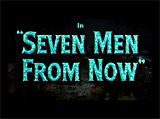
|
Decision at Sundown (1957)
A grim, psychological (and philosophical) revenge Western - another of the seven westerns pairing Boetticher with Randolph Scott. It opened with the marriage of crooked businessman Tate Kimbrough (John Carroll) to pretty blonde Lucy Summerton (Karen Steele) in Sundown, Arizona's church. Seeking twisted and obsessive revenge (over the previous three years) against Tate for seducing his dishonored late wife Mary in his hometown of Saving Pass and prompting her suicide was Texan Bart Allison (Randolph Scott), accompanied by best friend Sam (Noah Beery, Jr.). Bart threatened to kill Tate by sundown. Complicating matters was the presence of womanizing Tate's saloon girlfriend/mistress Ruby James (Valerie French), and Sam's revelation to Bart that Mary was the unfaithful trampish one. The film concluded with a long and tense stalemate and much soul-searching amongst the townsfolk about their rotten town (led by the righteous local Dr. John Storrow (John Archer)), while Bart was surrounded with Sam in the town's livery stable by the malevolent Tate and his hired men (including the town's corrupted sheriff Swede Hansen (Andrew Duggan)). The climactic shoot-out and gunfight (with wounded Bart shooting left-handed) ended with a twist - Ruby shot and wounded Tate, forcing the conflicted Bart to allow Tate to ride away from the town and never return. |
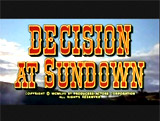
|
Forty Guns (1957)
Writer/producer/director Samuel Fuller's low-budget, campy, bawdy (with obvious phallic double-entendres), action-packed, violent, melodramatic, and stylized western starred Barbara Stanwyck as stern cattle-queen rancher Jessica Drummond. Riding a white stallion and dressed in black, she was a domineering matriarch who ruled an Arizona county, supported by her private posse of 'forty' hired guns, and in control of the town's cowardly and weak sheriff Ned Logan (Dean Jagger). Inevitably, she would fall (or find redemption), as per the words of the western's theme song: "She's a High Ridin' Woman with a whip... But if someone could break her and take her whip away, someone big, someone strong, someone tall, you may find that the woman with a whip is only a woman after all." When confronted by non-violent, Wyatt Earp-like, ready-to-retire federal lawman and ex-gunman Griff Bonell (Barry Sullivan) and his itchy-fingered brother, Wes (Gene Barry), and the younger Chico (Robert Dix), she also revealed her own troublesome, hot-headed brother: the evil and psychotic bully Brockie (John Ericson). After Wes romanced Louvenia Spanger (Eve Brent), the pretty daughter of a local gunsmith, they were married although their ceremony was marred when Brockie murdered Wes (he was aiming for Griff). In the climactic stand-off, Marshal Griff retaliated (10 years after his last killing) and mercilessly gunned down Brockie, who was using Jessica as a shield. He told bystanders: "Get a doctor, she'll live." In the end, Jessica was tamed and joined Griff as he rode out of town on a buckboard to California. |
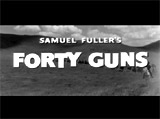
|
Gunfight at the O.K. Corral (1957)
Hollywood's ahistorical version of the Wyatt Earp-Doc Holliday legends, focusing on the years 1879 to 1881, was also dramatized in director Allan Dwan's Frontier Marshal (1939) with Randolph Scott, John Ford's My Darling Clementine (1946) and the more recent Tombstone (1993) and Wyatt Earp (1994). The film's tagline tauted its main feature: "The Wildest Gunfight in the History of the West." It was derived from a screenplay by novelist Leon Uris, and based on a 1954 article in Holiday Magazine titled The Killer by George Scullin. The film opened with sequences set in Dodge City, Kansas and Fort Griffin, Texas, to set up the subsequent action and introduce the characters. After his long career as a legendary lawman, the upright Wyatt Earp (Burt Lancaster) with his love interest - poker gambler Laura Denbow (Rhonda Fleming), moved to Tombstone, Arizona to help clean up the town and help his brother Virgil (John Hudson) - Tombstone's town marshal. Others helping them were Morgan Earp (DeForest Kelley) and the youngest Earp brother James (Martin Milner). Also in Tombstone was Earp's reluctant ally, terminally-ill gambler John "Doc" Holliday (Kirk Douglas) who amused himself in a tempestuous relationship with trampish Kate Fisher (Jo Van Fleet). Complications arose after Kate joined up with powerful thieving cattle rustler Ike Clanton's (Lyle Bettger) wily hired gun Johnny Ringo (John Ireland), and young James Earp was shot in the back and killed during a mistaken-identity ambush. The western concluded with a 5-minute bloodbath shooting at the O.K. Corral - a showdown between the Earps and Clantons. In the film's version, all six in Clanton's gang were killed, including young Billy Clanton (Dennis Hopper) who was given a chance to surrender, but refused. [Note: In reality, the shootout on October 26, 1881 did not take place in or next to the O.K. Corral, and was over in 30 seconds, with an exchange of 34 bullets, and the deaths of three men: Billy Clanton and two McLaury brothers (Tom and Frank). Virgil, Morgan, and Holliday were wounded. After the stand-off, the Earp Brothers were immediately arrested for murder and put on trial, but were acquitted for acting lawfully.] |
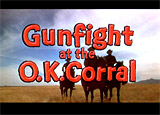
|
The Tall T (1957)
Another of the Boetticher-Scott collaborations. The film's unrelated title referred to name of the Tenvoorde ranch in the early scenes. On foot after losing his horse in a bet, unmarried rancher Pat Brennan (Randolph Scott) was picked up by a stagecoach driven by his old buddy Rintoon (Arthur Hunnicutt), traveling from Contention to Bixby. The unlikely passengers were two honeymooning newlyweds, unsympathetic, fortune-hunting Willard and timid and homely Doretta Mims (John Hubbard and Maureen O'Sullivan). Bandits soon ambushed them at the stage relay station (where the trio had already murdered the station manager Hank Parker (Fred E. Sherman) and his son Jeff (Chris Olsen)): sadistic and menacing gang leader Frank Usher (Richard Boone), trigger-itchy Chink (Henry Silva), and the impressionably young Billy Jack (Skip Homeier). Rintoon was killed by Chink and the others were taken hostage. Negotiating with the outlaws, the cowardly Willard unwisely sold out his new wife, confessing that her wealthy father could afford to pay them a ransom of $50,000 - he soon met his fate. Brennan and the distraught widow Doretta were kept prisoner in a remote dark cave hideout in the hills and became romantically involved after Willard's murder, and her confession that she married him out of loneliness. Brennan used her as sexual bait to lure Billy Jack and shoot him dead, and then killed Chink. When Usher returned with the ransom money, Brennan was also forced to kill Usher when he charged with his guns blazing. |
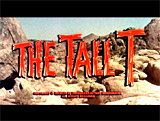
|
3:10 To Yuma (1957)
Another taut, low-budget psychological "adult" western (centering on a tense cat-and-mouse game between the two leads), with obvious similarities to High Noon (1952), and highlighted by Frankie Laine's title song. Remade in 2007. Poor, family-man, frontier rancher Dan Evans (Van Heflin) heroically accepted a job (with a $200 reward) to transport desperate outlaw Ben Wade (Glenn Ford) to prison. Wade was wanted for stage robbery and for the murder of the stage driver Bill Moons - the womanizing and charismatic desperado was apprehended while romancing forlorn saloon-girl Emmy (Felicia Farr) in town. The two were forced to wait in a hotel room in the town of Contention City, Arizona for the 3:10 pm train to Yuma, where Wade would stand trial. Smooth-talking Wade tempted civic-minded, dutiful Evans with a promise of $10,000 if he was released. The townsfolk and others (including Bob Moons (Sheridan Comerate), the drunken brother of the deceased, Evans' worried wife Alice (Leora Dana), and the leader of Wade's gang Charlie Prince (Richard Jaeckel)) provided additional problems for Evans - misgivings, threats, taunts, and bribes, etc. |

|
The Tin Star (1957)
A low-budget character-study western about frontier justice, nominated for a Best Original Story & Screenplay Oscar. Cynical veteran bounty-hunter (ex-tin star sheriff and widower) Morgan (or "Morg") Hickman (Henry Fonda) brought the body of a dangerous outlaw into a small western town to claim his reward for killing the stage robber and murderer Bogardus. There would be four days of delays, according to young, idealistic, brash, greenhorn and temporary sheriff Ben Owens (Anthony Perkins) and other townsfolk, who first needed to verify the wanted man's body. Meanwhile, Morgan (when denied boarding in town) was given a room by pretty blonde and widowed mother Nona Mayfield (Betsy Palmer), with a young half-breed son Kip (Michel Ray). Ben's critical sweetheart Millie Parker (Mary Webster) worried that he was doomed to be dead as a sheriff, like her father who was killed during a stagecoach robbery. Morgan began to teach the inexperienced and ineffective Ben the ways of a lawman (how to handle guns and outlaws and protect himself), made more challenging by the murder of the town's 75 year-old Doctor Joseph J. "Doc" McCord (John McIntire) on his birthday - "Doc" was killed by the same two stagecoach outlaws, the half-breed McGaffey brothers (Lee Van Cleef as Ed, and Peter Baldwin as Zeke), that had killed Millie's father. Millie's fears for the nervous and inept sheriff were realized when bigoted, bullying livery stable owner Bart Bogardus (Neville Brand), the dead outlaw's cousin, demonstrated his rivalry for the sheriff's job. He confronted Ben and a recently-deputized Morg (who had both successfully brought in the Indian-blooded bad guys) with an angry lynch mob. It was a typical showdown between the two lawmen and mob rule (denying the criminals a fair trial), with Ben proving his manhood (and the strength of his law-and-order tin star) against the hot-headed and barbarous Bart by shooting his dead. Impressed by Ben, Millie decided to marry him, while Morg, Nona and Kip left town to begin a new life together. |
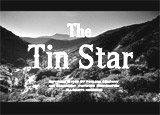
|
The Big Country (1958)
An epic western with an enormous cast of characters, and a story about powerful families feuding over water rights (interpreted by some as an allegory about the Cold War nuclear standoff). Co-producer Gregory Peck starred as James McKay, a wealthy and newly retired sea captain from Maryland who had traveled westward to meet up with his spirited fiancee Patricia (Carroll Baker) at the Ladder Ranch owned by her proud father Major Henry Terrill (Charles Bickford). There was continuing rivalry between Terrill and Blanco Canyon's stubborn and patriarchal Rufus Hannassey (Burl Ives, Best Supporting Actor winner), and in the middle of the feud was the "Big Muddy" ranch (with control of water rights to the river) owned by Patricia's headstrong yet sensible schoolteacher friend Julie Maragon (Jean Simmons). Challenging and taunting pacifist McKay's manhood (and calling him cowardly) was both Terrill's cocky foreman Steve Leech (Charlton Heston) and Rufus' troublesome, hot-headed and irresponsible son Buck (Chuck Connors). (One celebrated scene was an exhausting fisticuffs brawl at dawn between Leech and McKay, when the latter proved himself.) McKay purchased the key "Big Muddy" strip of land from Julie (with whom he also began a romance), alienating Patricia (and breaking their engagement) when he told her that he would continue to allow peace-keeping water rights for both families. In the exciting conclusion, Hannassey kidnapped Julie (to lure Terrill into narrow Blanco Canyon for ambush) and Buck threatened to rape her. McKay and Buck faced each other in a duel, revealing that Buck was the real coward. Hannassey shot and killed his own son when he threatened to unfairly shoot McKay in the back. Then, during a one-on-one showdown between Hannassey and Terrill, both were left dead. |
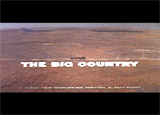
|
Cowboy (1958)
This fish-out-of-water western (and coming of age story) was an adaptation of Frank Harris' semi-autobiographical novel My Reminiscences as a Cowboy. Real-life writer and Chicago hotel desk clerk Frank Harris (Jack Lemmon), with aspirations of becoming a cowboy, saw his opportunity. When experienced tough cowboy/cattle driver and trail boss Tom Reece (Glenn Ford), with a penchant for whiskey and hot baths, lost his savings in a poker game, greenhorn Harris offered $3,800 to help finance Reece's purchase of a herd of cattle in Guadalupe, Mexico from Mexican baron Señor Vidal (Donald Randolph) - in exchange for becoming his ranch hand partner during his dusty travels to/from Mexico. After traveling by train to Wichita, and then arriving in Guadalupe seven weeks later, they rode to the Vidal ranch to arrange to pick up the herd, for transport back to market. In a side story, tenderfoot Harris was motivated by romantic interest in Vidal's daughter Maria (Anna Kashfi), but was dismayed when her disapproving father arranged her marriage to Don Manuel Arriega (Eugene Iglesias). By film's end, Harris had proved himself to Reece, in the midst of Indian scuffles, challenges on the trail with other trailhands and with the cattle. |
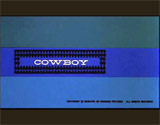
|
Man of the West (1958)
Director Anthony Mann's last western. After being robbed (of the savings of his community of Good Hope, raised to hire a schoolteacher) while on a train to Fort Worth, Texas, family man Link Jones (Gary Cooper) - with a dark and troubled past - was joined up with Crosscut (Texas) saloon singer Billie Ellis (Julie London) and cardsharp con-man Sam Beasley (Arthur O'Connell). The trio came upon an isolated, broken-down ranch house where Link, now reformed, revealed he had once been raised and trained as a gang member to rob banks. Inside, he was startled to find the thieves and their patriarchal leader Dock Tobin (Lee J. Cobb) - Link's uncle. Jones found himself defending the honor of Billie when the twisted Dock lusted after her, and gunman Coaley Tobin (Jack Lord) made her strip down to her underwear. Link was compelled to rejoin the robbers for a bank heist in the (ghost)town of Lassoo. By the film's end, Link had killed off a number of gang members, but found that in his absence, Billie had been raped (off-screen) and beaten. In retaliation in the film's climactic end, he killed Dock and reclaimed the stolen funds. |
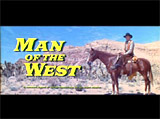
|
The Horse Soldiers (1959)
This docudrama's plot was inspired by the true story of Union Army Colonel Benjamin Grierson, who led a daring and successful "Grierson's Raid" before the Battle of Newton Station, to cut the Confederate-controlled railroad line connecting the supply depot of Newton Station with the stronghold Southern city of Vicksburg - this military action in Mississippi occurred just prior to the famous Battle of Vicksburg in 1863. In Ford's western version, John Wayne starred as Yankee cavalry brigade leader Colonel John Marlowe (who later revealed that he was an engineer who built railroads before the war). Marlowe conducted a raid of saboteurs to cause havoc and destroy a Confederate railroad and supply depot 300 miles behind the lines at Newton Station. Feuding and bickering continually with Marlowe (who had a deeply-founded hatred of doctors) was his new humanitarian, self-righteous regimental surgeon Major Henry "Hank" Kendall (William Holden). Fiery Southern belle and Greenbriar Landing plantation mistress Miss Hannah Hunter (Constance Towers) was taken hostage after she overheard their plans and would undoubtedly have undermined their mission as a spy if left behind. A major military action occurred when the Union forces were surprise counter-attacked by Confederate forces at Newton Station, although it ended with the Union army blowing up the depot and destroying the railroad lines. A second attack was conducted against Marlowe's brigade by uniformed young school children cadets from a nearby military institute, marching to war to the sound of fife and drum. As Marlowe and his men retreated to avoid conflict with the underaged soldiers and pushed further southward, he was wounded at a crucial bridge crossing, although he was able to lead a successful attack to rout the Confederates. Just before mining and blowing up the wooden bridge and crossing into Louisiana, he bid farewell to love interest Hannah, and to Kendall who chose to remain behind (and was facing certain imprisonment at Andersonville). |

|
Ride Lonesome (1959)
Another Boetticher/Randolph Scott collaboration in a B-grade western about revenge - one of seven collaborations (and the best) of their superb films, filmed (with CinemaScope) on location in the Sierra Nevada Mountains. The hero was taciturn bounty hunter Ben Brigade (Randolph Scott) - the aging ex-sheriff of Santa Cruz, Arizona. In the opening scene, he captured no-good drifter Billy John (James Best) among some rocks. The fugitive was wanted for shooting a man in the back in Santa Cruz. Brigade's intention was to take captive Billy John to the Santa Cruz County jail - and meanwhile, vengefully use Billy John as bait to also capture his sadistic older outlaw brother Frank John (Lee Van Cleef) - his real motive was not the money, but personal revenge. In the back-story, Frank had kidnapped Brigade's wife years earlier when he was the Sheriff of Santa Cruz, and murdered her by hanging at the site of a hanging tree (a day's ride outside Santa Cruz) - Brigade was on an obsessive quest to avenge her murder. Two other outlaws involved in the plot were also interested in the bounty on Billy John's head. They eventually accompanied Brigade during his journey: Sam Boone (Pernell Roberts) and his companion Whit (James Coburn in his screen debut). Also joining them was shapely blonde Mrs. Carrie Lane (Karen Steele) who was first seen at her stagecoach way station. It was eventually discovered that a marauding Mescalero Indian attack had killed her stagecoach trading post husband. Throughout the film, the image of the 'Hang Tree' was a defining metaphor for death - when the group rode up to the dead tree, Boone spoke: "You can be glad it ain't long ago, Billy Boy. It was, like as not, Brigade here to hang you over that jury limb and have it over. Gone dead now, but in its time, more than one danced their last one there. Ain't that right, Brigade?...Come to think of it, you strung a few there yourself." In the conclusion set at the hang tree, Frank challenged Brigade to give up his brother Billy John; with his guns blazing, Frank charged on his horse toward the hanging tree and at Brigade where Billy John was tied up on horseback and had a noose around his neck. Brigade shot and killed Frank, then cut down Billy John swinging by the noose before he died. Unpredictably, Brigade surrendered Billy John to Boone and Whit (and the young widow Mrs. Lane): (Boone was shocked: "You mean I can have him?...Funny ain't it? How a thing can seem one way, and then turn out altogether somethin' else"). The threesome then proceeded on toward Santa Cruz for the bounty, leaving Brigade to again 'ride lonesome' - he stood alone at the hanging tree that he had set on fire, as the camera rose up with the smoke and flames. |
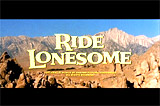
|
Rio Bravo (1959)
Filmed by Hawks as a reaction to High Noon (1952), and remade as El Dorado (1966) and John Carpenter's action-thriller Assault on Precinct 13 (1976). John Wayne starred as self-reliant small-town Sheriff John T. Chance, who enlisted the help of a group of misfits: drunken deputy Dude (aka Borachón - Spanish for drunk) (Dean Martin), teenaged cocky sharpshooter Colorado Ryan (singer Ricky Nelson), and elderly, limping and grumpy sidekick Stumpy (Walter Brennan), while finding love with stranded, on-the-run dance-hall girl Feathers (26 year-old Angie Dickinson), who was on her way to Fort Worth. They were guarding jail inmate Joe Burdette (Claude Akins), who was charged with the murder of an unarmed bystander in a saloon fight (in the film's opening). His ruthless land baron brother Nathan Burdette (John Russell) and hired guns attempted to release him, before he could be taken by a US Marshal to Presidio for trial. A final shoot-out amidst overturned wagons (filled with dynamite cargo) defeated Burdette's men. |
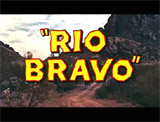
|
(chronological by film title) Introduction | Silents-1930s | 1940s | 1950-1955 | 1956-1959 | 1960-1965 1966-1969 | 1970s | 1980s-1990s | 2000s | 2010s |